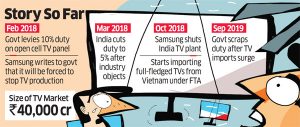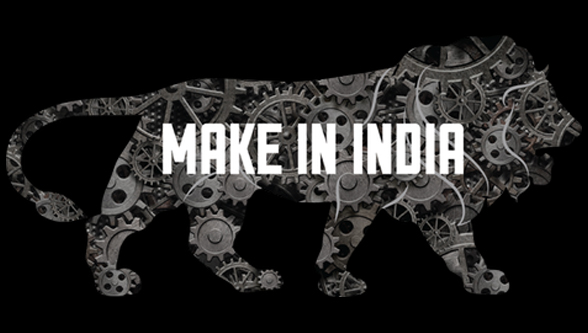India has achieved significant success in the Ease of Doing Business World Bank rankings over the past couple of years which was one of the primary aims Make In India. The country has, however, not accomplished the goal it had set out to achieve through the ambitious project. In this article we try to analyse where we have gone haywire in realising the goal of Make In India….
Article by Arijit Nag
Make In India is one of the pet projects of the Indian Prime Minister, Mr Narendra Damodardas Modi. Just a few months after the Bharatiya Janata Party-led NDA came to power in 2014, Modi announced a slew of projects to fulfil his dream of ushering in a New India which included Make in India, Jan Dhan Yojana, Swaachh Bharat to name a few.
The ‘Make in India’ programme was launched on September 25, 2014 with the express aim to make India a global hub for manufacturing, research and innovation and integral part of the global supply chain. It has been a perennial heart burn for India that China made huge strides in manufacturing while India lagged far behind.
However, the success rate of the scheme can be said patchy at best. There have been huge plans but implementation has left a lot to be desired. The scheme has not really been backed by either infrastructure or cost benefit analysis.
Thousands of crores were allocated for these projects. The promises made by the government were sky-high and the sleeping tiger, that India was, seemed to be waking up. In 2014, the Modi-I regime came to power promising millions of new and higher-paying jobs, greater business investment opportunities, greater privatisation and diminished corruption. But these milestones were not realised to a great extent.
The Make in India project required India to climb up significantly on the “Ease of Doing Business” ranking of the World Bank. The country has climbed to the 63rd rank among 190 countries in the World Bank’s ease-of-doing-business ranking. The leap of 14 places from 2018 puts India among the top 10 improvers in rank yet again, according to the World Bank report. This has indeed been a credible achievement of the government.
In 2014, Modi’s favourite slogan was “Minimum government, Maximum governance”. However, what we subsequently saw was a bigger government trying to be more efficient, i.e. in terms of increasing relative access to some public goods and welfare schemes at local levels. We have actually seen the Modi government function as a large monopolistic behemoth — spending more on public relations campaigns and marketing, with a servile bureaucracy.
Recently, Union Defence Minister Rajnath Singh while addressing India Rising, a business seminar organised by the Indian Chamber of Commerce at the Defence & Security Exhibition 2019, said that India was committed to achieving $26 billion defence industry by 2025 through Make in India. But many experts differed from him.
Even as the government draws a roadmap to give a significant fillip to Make in India, country’s top bureaucrats and multinational companies feel a lot needs to be done still to make it a success such that more and more companies are willing to set up manufacturing base here.
“Lot still needs to be done in Make in India and focus on defence manufacturing will go a long way in doing that,” NITI Aayog CEOAmitabh Kant said.Kant, who has been the man behind the Make in India programme, was speaking at a session on Make in India at the Economic Times Global Business Summit recently.
Samsung, the largest television brand in India, is a very relevant case study as far as the lacuna in the implementation of Make in India is concerned. Samsung’s Chennai plant was shut in October last year after the government imposed duty on open cell television panels. The company then started importing finished television sets from its plant in Vietnam through the free trade agreement (FTA) route.
In September, the Centre scrapped the five per cent import duty on open cell panels. The display accounts for almost 65-70 per cent of the production cost of LED televisions. There are currently no domestic manufacturers of television panels even though the government has been trying to push local production of this component.

Consumer demand and spending have witnessed an alarming plunge in recent times. The Indian television industry has been going through one of its worst phases with sales remaining mostly flat through 2019 despite the cricket World Cup and Diwali. Consumers are increasingly buying Chinese and online value brands such as Xiaomi, TCL, Kodak and Thomson in screen sizes up to 43 inches, which forced Samsung, Sony and LG to drop prices by 20-40 per cent.
Against this backdrop, the government applied intense pressure on Samsung to restart production since its exit was a blot on the flagship Make in India programme. This is also expected to help Samsung since it can better manage its supply chain and save on logistic costs now that there is no cost difference between local manufacturing and FTA imports,” added one of them.
Hence, Samsung India has decided to bring back television production to India after a year with the government scrapping import duty on the biggest component open cell panel, or displays, according to several news reports.
The South Korean electronics company is about to sign a deal with homegrown contract manufacturer Dixon Technologies to manufacture television sets of up to 55 inches in screen size. These account for more than 85 per cent of the Indian market. The company is evaluating options with other contract manufacturers to further expand local TV production in India.
Samsung may also start the TV line in its Chennai plant provided the government assures the company that the nil duty on open cell TV panels will continue for a few more years till local production of it begins.
According to Kant, enforcement of contracts is one of the weak areas of doing business in India and this needs to be improved. “India has shown significant improvement in nine out of 10 parameters of ‘ease of doing business’. The only place where we need to improve is the enforcement of contracts in which judiciary and not the executive has a major role to play,” Kant said, adding that all of us have to work around it.
Anil Swarup, secretary in the ministry of human and resource and development said India needs to bring in consistency in innovation in existing institution/systems to improve quality of education.”By aping the West we are not making in India. We need to look inwards and come up with ideas that are politically acceptable, financially viable and administratively doable,” Swarup added.
The government is striving to make India a better place to do business with the aim to be in the top 50 nations in the World Bank’s ease of doing business report. For the first time in 2017, India moved up 30 positions to be among top 100 nations after persistent efforts over the last three years to improve upon the ease of doing parameters.
The government has recently launched Make in India 2.0 with renewed emphasis on 10 sectors, including capital goods, auto, defence, pharmaceutical and renewable energy to push growth in manufacturing and generate job opportunities.
According to Bloomberg news, India is planning to offer 324 companies including Tesla Inc. and GlaxoSmithKline Plc incentives to set up factories in a bid to capitalise from the trade war between China and the U.S.
This time around the government proposes to provide the manufacturers land to set up plants along with power, water and road access, according to a draft of the document prepared by the Department for Promotion of Industry and Internal Trade and Invest India.
While the Sino-US trade war has benefited countries like Vietnam and Malaysia into becoming manufacturing hubs through relocation of multiple manufacturing units, rigid land acquisition rules and labour laws have prompted investors to largely ignore India when looking for alternatives to China. However, Make in India 2.0 may reduce red tape, and set the nation, which expanded at the slowest pace in six years last quarter, on a path to double its gross domestic product to $5 trillion by 2025 — a goal set Prime Minister Narendra Modi.
Article by….
Arijit Nag is a freelance journalist who writes on various aspects of the economy and current affairs.




